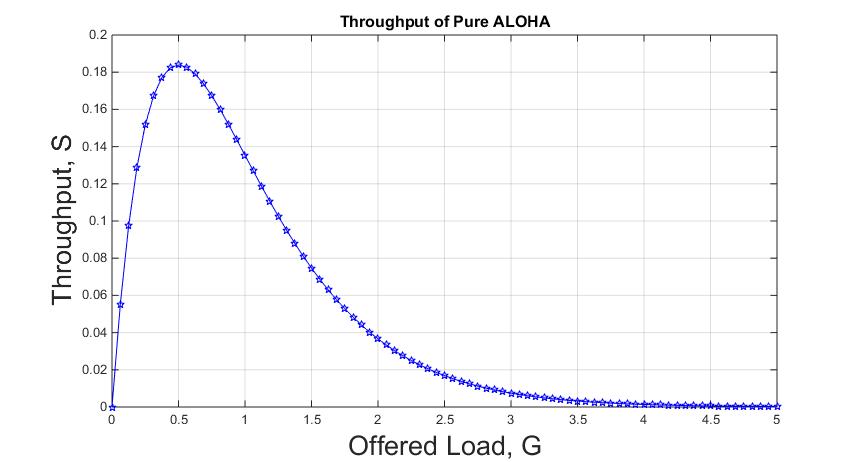1. 简介
在多节点共享通信信道的网络环境中,随机访问协议(Random Access Protocols)是一种非常基础且重要的通信机制。它允许网络中的各个节点在不需事先授权或轮询的情况下,自主决定是否发送数据。
本文将聚焦于最早期的随机访问协议之一:纯ALOHA协议(Pure ALOHA)。我们将从整体的随机访问协议入手,逐步深入讲解Pure ALOHA的工作机制、吞吐量模型及其优缺点。
2. 随机访问协议概述
随机访问协议的核心思想是:多个节点共享一个通信信道,并通过某种机制竞争使用该信道。它们并不按照固定顺序发送数据,而是根据自身需求随机发送,因此可能会发生数据冲突(collision)。
常见的随机访问协议包括:
- ALOHA
- CSMA/CD
- CSMA/CA
- TDMA
- FDMA
- 802.11
我们简要说明每个协议的核心机制。
2.1 ALOHA
ALOHA 是最早期的随机访问协议之一,诞生于上世纪70年代的夏威夷大学 ALOHAnet 网络中。它的核心规则非常简单:
✅ 节点可以随时发送数据
❌ 无冲突检测机制
✅ 若发送失败(检测到冲突),则等待一段随机时间后重传
ALOHA 有两个变种:
- Pure ALOHA:节点可随时发送,无时间同步
- Slotted ALOHA:将时间划分为“时隙”,只能在时隙开始时发送,从而降低冲突概率
2.2 CSMA/CD
CSMA/CD(载波侦听多路访问/冲突检测)主要用于有线以太网。其核心机制是:
✅ 发送前先监听信道是否空闲
✅ 若空闲则发送数据
✅ 发送过程中持续监听,检测是否发生冲突
✅ 若冲突则发送“拥塞信号”并暂停发送,等待随机时间后重试
这种机制在局域网中非常有效,因为冲突容易检测。
2.3 CSMA/CA
CSMA/CA(载波侦听多路访问/冲突避免)主要用于无线网络(如Wi-Fi)。由于无线信道中冲突难以检测,因此引入了“请求发送/允许发送”机制:
✅ RTS(Request to Send)
✅ CTS(Clear to Send)
✅ 数据传输
✅ ACK确认机制
这种机制通过预约信道来避免冲突,但增加了协议开销。
2.4 TDMA
TDMA(时分多址)将时间划分为多个“时隙”,每个用户在固定时隙内发送数据。优点是冲突几乎为零,适用于蜂窝网络和卫星通信。
2.5 FDMA
FDMA(频分多址)将频率带宽划分为多个子频段,每个用户在自己的频段上通信。也常用于无线通信系统中。
2.6 802.11
IEEE 802.11 是Wi-Fi的物理层和MAC层标准,其MAC机制主要基于 CSMA/CA,是现代无线局域网的基础。
3. 纯ALOHA协议详解
3.1 基本机制
纯ALOHA(Pure ALOHA)是一种非常早期、简单的随机访问协议。其核心思想是:
✅ 节点可以随时发送数据帧
❌ 无需检查信道状态
✅ 若发送失败(即发生冲突),则等待随机时间后重传
它没有同步机制,也没有冲突检测,因此效率较低,但其思想为后续协议提供了重要基础。
下图展示了纯ALOHA中数据帧的发送与冲突示意图:

3.2 协议流程
以下是纯ALOHA协议的典型工作流程:
- 节点监听信道,若信道空闲则发送数据帧
- 发送完成后等待一段随机时间
- 检测是否收到接收方的ACK确认
- 若收到ACK → 成功发送
- 若未收到ACK → 假设发生冲突
- 若冲突,等待随机时间后重传
- 重复步骤4直到成功或达到最大重试次数
3.3 吞吐量模型
纯ALOHA的吞吐量(Throughput)可以用如下公式表示:
$$ S = G e^{-2G} $$
其中:
- $ S $:吞吐量(即成功传输的数据量)
- $ G $:单位时间内的平均发送尝试次数
- $ e $:自然对数的底(约等于2.71828)
当 $ G = 0.5 $ 时,吞吐量达到最大值:
$$ S_{\text{max}} = 0.184 $$
这意味着,纯ALOHA协议的最大吞吐量仅为信道容量的约18.4%。
下图展示了吞吐量随 $ G $ 变化的趋势:

虽然这个效率很低,但它的提出为后续更高效的协议(如 Slotted ALOHA、CSMA 系列)奠定了基础。
4. 小结
纯ALOHA是一种早期的随机访问协议,虽然实现简单,但由于其无冲突检测机制和高冲突概率,导致其吞吐效率较低(最大仅18.4%)。
✅ 优点:实现简单,适合低负载场景
❌ 缺点:冲突频繁,效率低下
✅ 意义:为后续更高效协议(如 Slotted ALOHA、CSMA/CD)提供了理论基础
在实际应用中,纯ALOHA已基本被更高效的协议所取代,但理解它的机制对学习网络协议的发展脉络仍然具有重要意义。